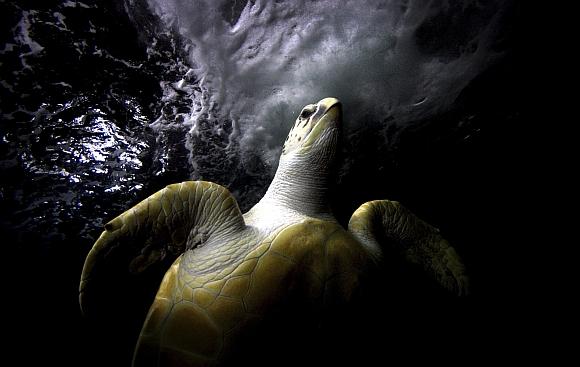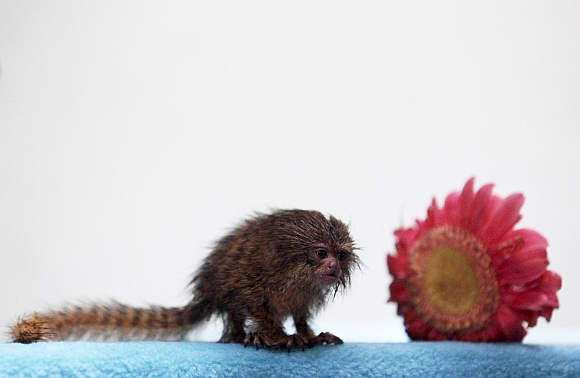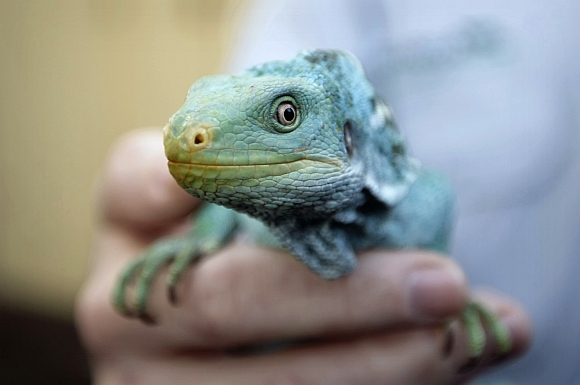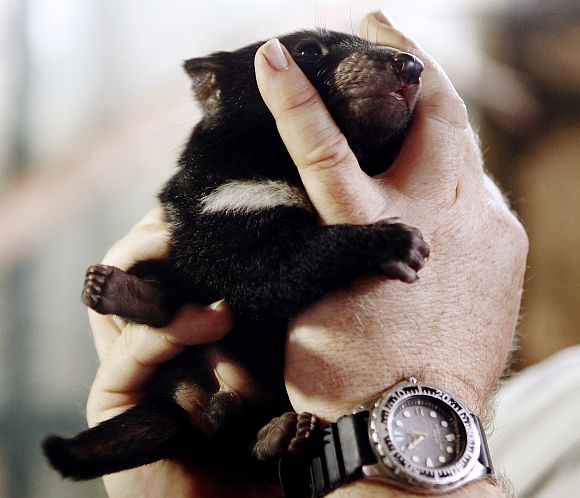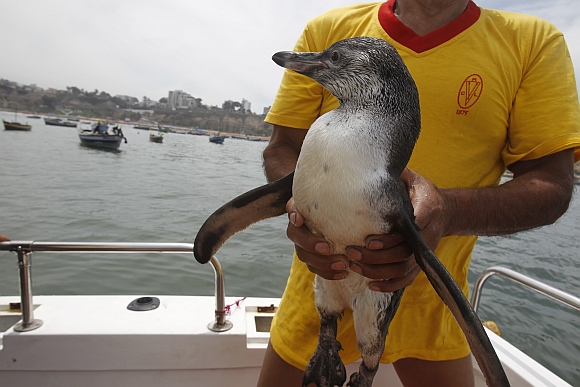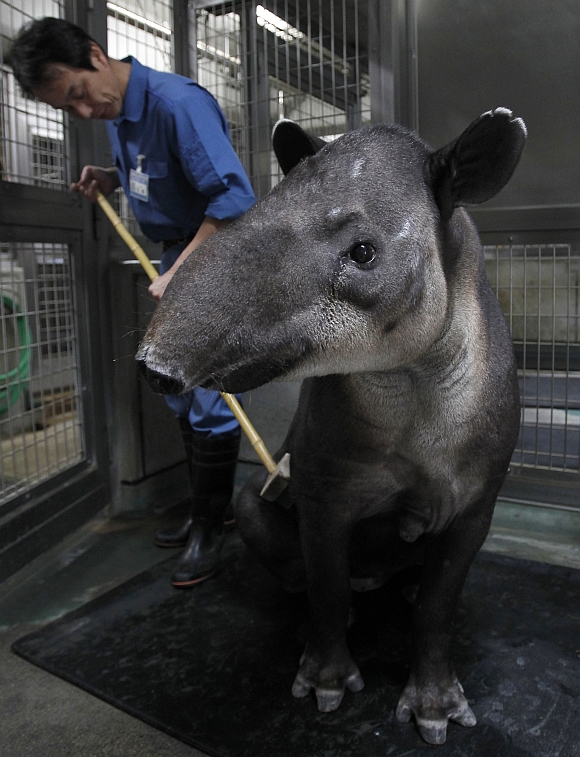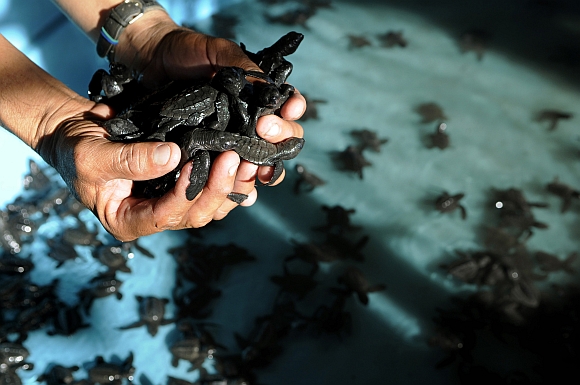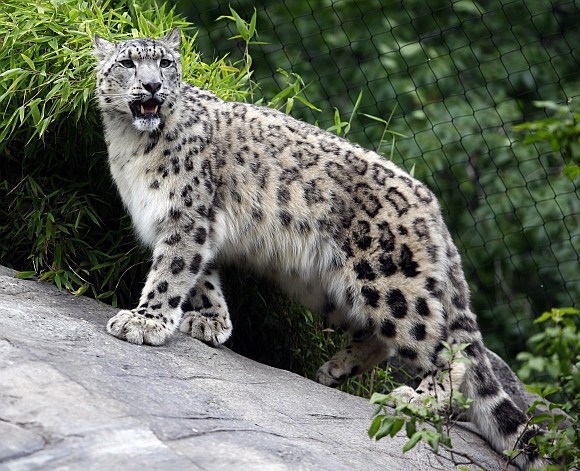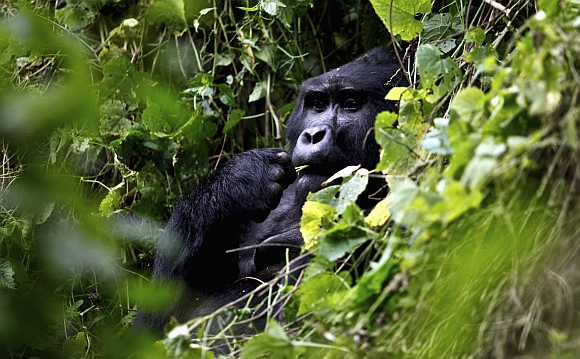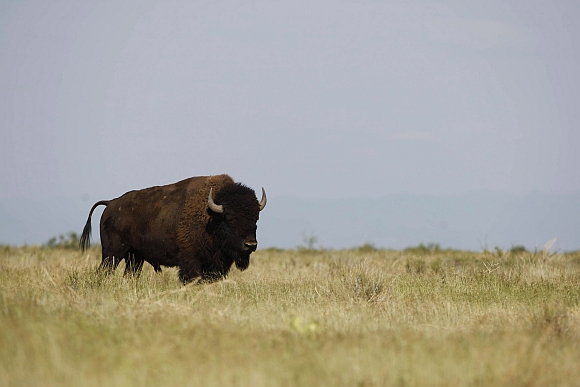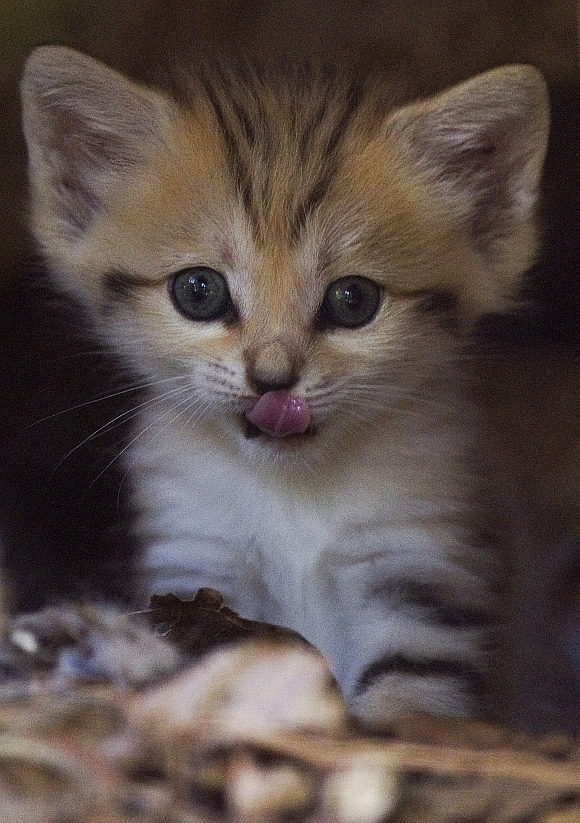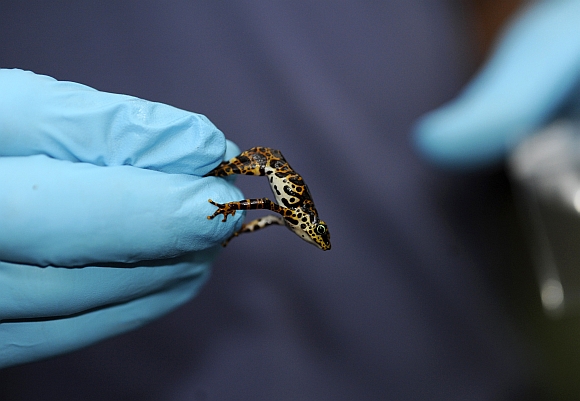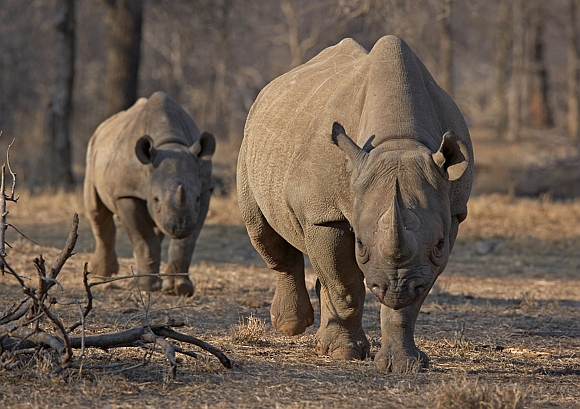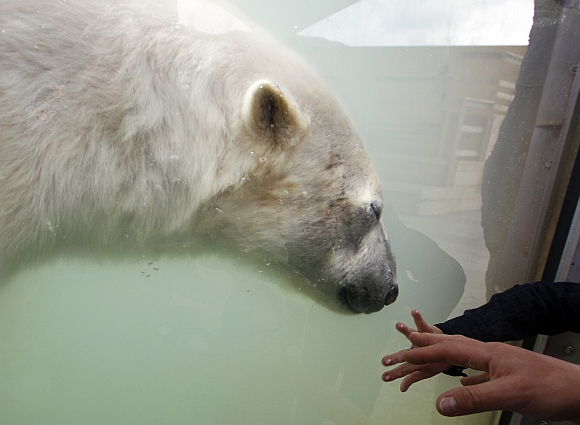 | « Back to article | Print this article |
Leatherback marine turtle
Some of the most unique animals today are at the risk of becoming extinct. In 2010 -- the International Year of Biodiversity -- the United Nations wanted efforts to slow the accelerating pace of extinctions to reach beyond nature lovers, to companies and economists. Shifting emphasis from emotional images of polar bears, pandas or leatherbacks that stress the fragility and beauty of nature, the focus was on a harder-headed assessment of how the natural world is a key to economic growth and new products. Rediff.com takes a look at efforts being made across the globe to save these dying breeds.
The 167-kg leatherback marine turtle known as Tommy swims at the Sydney Aquarium, where it was moved in April 2006.
Pygmy Marmoset
A Pygmy Marmoset (Callithrix pygmaea) is seen at a primate rescue and rehabilitation center near Santiago. The Pygmy Marmoset, known as the world's smallest monkey and under danger of extinction, was confiscated after being found inside the clothes of a Peruvian citizen during a highway police check at the northern city of Antofagasta, some 1367 km of Santiago.
Fijian Crested Iguana
A zookeeper holds a Fijian Crested Iguana at Taronga Zoo in Sydney during an announcement of a funding boost for their conservation. Only a few wild populations remain of the endangered iguana which is found on a several Fijian islands. The species faces possible extinction due to habitat destruction and competition from introduced species.
Tasmanian Devil
An unnamed male Tasmanian Devil cub receives a health check in his enclosure at Sydney's Taronga Zoo.
The Tasmanian devil is a carnivorous marsupial of the family Dasyuridae, now found in the wild only on the Australian island state of Tasmania. The size of a small dog, it became the largest carnivorous marsupial in the world following the extinction of the thylacine in 1936.
Humboldt penguin
A lifeguard transfers Tomas, a lost Humboldt penguin, to a boat to travel to a penguin colony on San Lorenzo Island in January 26. Tomas was rescued by lifeguards after losing his way and landing at the beach of Agua Dulce in the Lima district of Chorrillos.
Humboldt penguins, poached for meat and sought after as household pets, are considered an endangered species according the Peruvian Ministry of Agriculture.
Baird's Tapir
A zookeeper brushes the back of a Baird's Tapir, an endangered species, inside her enclosure at the Preservation and Research Center in Yokohama, south of Tokyo. The facility, which is located at the breeding zone of Yokohama Zoological Gardens, is closed to the public to allow selected endangered species to breed in the most suitable environments and to study the endangered animals, according to the center.
Whale shark
Diver Brad Norman photographs a whale shark at Ningaloo Marine Park, off the coast of Western Australia. The 1000th whale shark, a rare and threatened species, has been discovered by researchers using a global programme in which eco-tourists and scientists identify new sharks and lodge photographs on an online library.
Golfina turtles
A man holds Golfina turtle hatchlings on Toluca Beach, 40 km south of San Salvador. Ecological authorities and volunteers released into the sea about 1,500 Golfina turtles born in captivity.
Golfina turtles, also know as Olive Ridley turtles, are endangered and are listed in Appendix I of the Convention on International Trade in Endangered Species of Wild Flora and Fauna.
Irrawaddy dolphin
An Irrawaddy dolphin sports a cowboy hat while performing tricks at the Oasis Sea World marine park in Chantaburi, nearly 290 km southeast of Bangkok.
Conservationists say irrawaddy dolphins, along with lions and tigers, are among the most sought after items on the black market, with the demand for the species threatening their survival.
Snow leopard
A snow leopard is seen at the new exhibit in Central Park Zoo, New York. The exhibit houses three snow leopards and offers visitors a view of one of the most endangered big cats on the planet.
Experts believe that about 300-500 adult snow leopards survive in Nepal, particularly in Manang, Mustang, Dolpa and Gorkha districts. The snow leopard, which lives around 5,000-6,000 meters above sea level, is considered a solitary animal.
Bengal Tiger
A three-month-old Bengal Tiger plays with a three-month-old lion cub at a zoo in Puerto Vallarta. The keepers at the zoo educate visitors and raise awareness on endangered animals around the world. The park's own tiger breeding programme has enjoyed success with more than 20 tigers born since 2010 including a rare white Bengal tiger, according to zoo vet Martin Martinz.
Silverback mountain gorilla
A silverback mountain gorilla is seen during a census inside Bwindi Impenetrable National Park, about 550 km west of Uganda's capital Kampala.
The census of the critically endangered mountain gorilla is being conducted by the Uganda Wildlife Authority in Bwindi, which is known to have more than half of the world's mountain gorillas. Teams comprising of rangers and wardens from Uganda, Rwanda and Congo are assembled in the Ruhija sector of the park to begin the pre-census sweep.
Giant panda
Giant panda cubs lie in a crib at Chengdu Research Base of Giant Panda Breeding in Chengdu, Sichuan province, China.
A 2007 report shows 239 pandas living in captivity inside China and another 27 outside the country. Wild population estimates vary; one estimate shows that there are about 1,590 individuals living in the wild, while a 2006 study via DNA analysis estimated that this figure could be as high as 2,000 to 3,000.
Bison
A bison stands on the grasslands of the "El Uno" ecological reserve in Janos, some 230 km from Ciudad Juarez.. Environmental authorities of the United States and Mexico are joining forces to reintroduce the American bison, which were almost on the verge of extinction in the 19th century, in the grasslands of northern Chihuahua state.
The Nature Conservancy believes that bisons are an essential part of the ecosystem in supporting populations of other species in the reserve. Bisons break the ground with their step and allow plants to grow, promote water filtration and keep the grass at a height perfect for other species like the prairie dog to thrive.
Sand cat
Renana, a three-week-old sand kitten, is seen at her enclosure in the Ramat Gan Safari near Tel Aviv in August. The kitten is the first of the sand cat species, considered extinct in Israel, to be born at the safari park, an open-air zoo, a statement from the safari said.
Toad Mountain Harlequin frog
Biologist Jorge Guerrel puts a tiny Toad Mountain Harlequin frog into a plastic bag for weighing and measuring on the slopes of Panama's Cerro Sapo. The endangered frog is likely to be wiped out in the wild by the imminent arrival of frog chytrid, a fungus that has decimated amphibian species across the globe in recent decades. Panama's Cerro Sapo is one of the few regions still partly free from the fungus.
Orangutan
Baby orangutan Boo, a nine-month-old orphan, lies on the ground during a presentation at the Madrid Zoo & Aquarium. Boo, the first orangutan born at the zoo, has been adopted by a female orangutan and is bottle fed by one of the keepers, according to the zoo.
Branded pests for venturing out from their diminishing forest habitats into plantations where they eat young palm shoots, orangutans could be extinct in the wild in ten years time, the United Nations said in 2007. Fighting against this grim prediction is the Nyaru Menteng Borneo Orangutan Survival centre in Central Kalimantan, which rescues orangutans and returns them to the wild at the cost of $3,000 per ape. The orangutans learn how to survive in the wild during forest school. They are taught to make nests, find the right foods and climb trees.
Grizzly bear
Borman Phillips, owner and operator of the Northwood Zoo and Animal Sanctuary handles three grizzly bear cubs in Seagrave Ontario.
Parks Canada estimates that up to 20,000 grizzly bears remain in western Alberta, the Yukon and Northwest Territories and British Columbia. The Committee on the Status of Endangered Wildlife in Canada lists the grizzly bear as a "Special Concern".
African black rhinoceros
An endangered east African black rhinoceros and her young one walk in Tanzania's Serengeti park, during the start of an initiative that will see 32 huge beasts flown to Tanzania from South Africa. An explosion in poaching in the 1960 and 70s saw the population of east African black rhinos in Tanzania plummet from over 1,000 to just 70. Seven of the remaining rhinos were relocated to South Africa in an effort to protect them and bring the rhino sub-species back from the brink of extinction.
Polar bear
Polar bear Rasputin swims at the Marineland aquatic park in Antibes, southeastern France.
There are currently 19 populations of polar bears in the Arctic, in Canada, Alaska (USA), Russia, Svalbard (Norway) and Greenland (Denmark). Thirteen of these populations occur either wholly or partially in Canada, ranging from the Ontario shores of Hudson Bay as far north as Ellesmere Island, Nunavut, and from northern Yukon in the west to Labrador in the east. Twelve of these populations occur at least partially in Nunavut.
